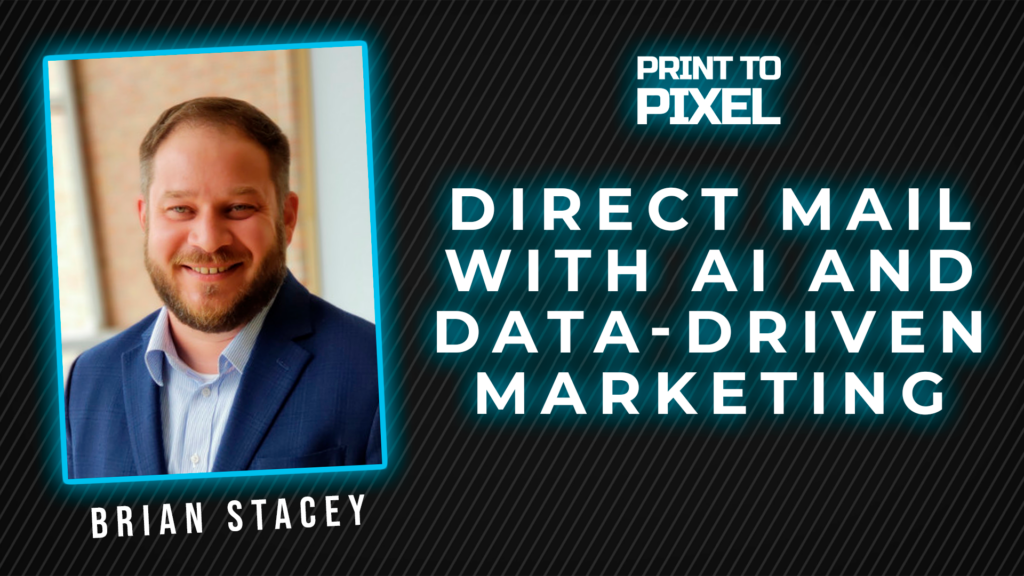In the latest episode of the Print to Pixel podcast, we had the privilege of speaking with Brian Stacey of Decision Science. Brian is a thought leader in leveraging data science for direct mail marketing to enhance marketing strategies, and he shared game-changing insights on how marketers, agencies, and nonprofits can use analytics to optimize their direct mail campaigns.

With the rise of digital marketing, many assumed direct mail would become obsolete. But as Brian explained, that couldn’t be further from the truth. Instead, data-driven direct mail is proving to be a powerful tool for brands looking to cut through the noise and deliver highly personalized experiences. Let’s dive into some of the key takeaways from our conversation.
Data Science: The Catalyst for Smarter Direct Mail
Direct mail is no longer about mass mailing and hoping for the best. Modern marketers use sophisticated analytics to target the right audience, at the right time, with the right message. Brian highlighted how Decision Science helps brands harness data science for direct mail marketing to predict consumer behavior, measure campaign effectiveness, and refine messaging strategies.
One major advantage of applying data science for direct mail marketing is predictive modeling. By analyzing historical customer data, marketers can determine who is most likely to respond to a campaign, leading to better engagement rates and higher ROI.
Personalization at Scale
A key takeaway from Brian’s discussion was how data science for direct mail marketing allows marketers to personalize direct mail campaigns at scale. Gone are the days of generic flyers—now, businesses can use variable data printing and customer insights to create hyper-relevant mailpieces tailored to individual preferences.
For example, a nonprofit can use donor history to send customized appeals based on giving behavior, or a retail brand can send exclusive offers based on past purchases. This level of personalization drives higher response rates and fosters stronger customer relationships.
Bridging the Gap Between Digital and Direct Mail
One of the most exciting trends Brian touched on is the seamless integration of direct mail with digital marketing. Many brands are now using data-driven strategies to connect their offline and online efforts, creating cohesive, omnichannel experiences.
For instance, a prospect who visits a website but doesn’t convert can receive a follow-up direct mail piece with a personalized incentive. Or, QR codes and personalized URLs (PURLs) on mailpieces can direct recipients to digital landing pages, enabling marketers to track engagement in real time.
The Role of AI and Machine Learning
Artificial intelligence (AI) and machine learning are becoming indispensable in data science for direct mail marketing. Brian explained how AI-driven analytics can help marketers predict customer intent, segment audiences more effectively, and automate campaign optimizations.
For example, AI can analyze which messaging resonates best with different segments, helping marketers refine their copy and design elements for maximum impact. Machine learning algorithms can also identify trends in response data, allowing businesses to tweak their strategies dynamically rather than waiting until the campaign ends.
Why Data-Driven Direct Mail Works
With email inboxes overflowing and digital ad fatigue setting in, direct mail has re-emerged as a highly effective channel for reaching consumers. According to industry studies, direct mail boasts higher response rates than digital channels, particularly when campaigns are backed by data science for direct mail marketing.
Brian shared a compelling case study where a company using Decision Science’s predictive analytics increased their response rates by over 30% simply by refining their targeting strategy. This proves that when brands leverage the right data, direct mail can outperform digital alone.
Measuring Success: Tracking and Attribution
One challenge marketers face with direct mail is attribution—how do you measure the impact of a physical mailpiece? Brian emphasized that by using unique tracking methods such as QR codes, PURLs, call tracking, and A/B testing, businesses can gain deeper insights into what works and what doesn’t.
Advanced analytics platforms can track when a recipient engages with a direct mail piece and attribute conversions accordingly. This enables brands to make data-driven decisions and optimize future campaigns for even better results.
Key Takeaways for Marketers, Agencies, and Nonprofits
For those looking to harness data science for direct mail marketing, Brian offered several actionable insights that his firm can assist with:
- Leverage predictive modeling – Use historical data to identify and target your ideal audience.
- Personalize your campaigns – Tailor messaging and offers based on customer behavior and preferences.
- Integrate direct mail with digital – Combine offline and online efforts for a seamless customer experience.
- Use AI for optimization – Let machine learning refine your campaigns for better performance.
- Track and measure results – Implement tracking methods to understand what’s working and continuously improve.
The Future of Data-Driven Direct Mail
As technology continues to evolve, direct mail will only become smarter, more targeted, and more measurable. With data science for direct mail marketing leading the charge, marketers can look forward to more efficient campaigns that deliver better engagement, higher ROI, and stronger customer relationships.
If you haven’t already embraced data-driven direct mail, now is the time. As Brian Stacey emphasized, the brands that integrate data science for direct mail marketing into their strategies will be the ones that stand out in an increasingly crowded marketplace.
Listen to the Full Episode
Want to dive deeper into these insights? Listen to the full episode of Print to Pixel featuring Brian Stacey to learn more about how data science for direct mail marketing is shaping the future of direct mail.
By applying these data-driven strategies, marketers, agencies, and nonprofits can unlock the full potential of direct mail and drive impactful results. Ready to optimize your direct mail campaigns? Contact Postalytics today to see how our automated direct mail solutions can help!
About the Author

Dennis Kelly
Dennis Kelly is CEO and co-founder of Postalytics, the leading direct mail automation platform for marketers to build, deploy and manage direct mail marketing campaigns. Postalytics is Dennis’ 6th startup. He has been involved in starting and growing early-stage technology ventures for over 30 years and has held senior management roles at a diverse set of large technology firms including Computer Associates, Palm Inc. and Achieve Healthcare Information Systems.
